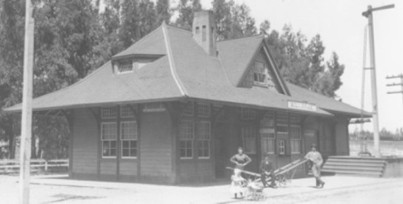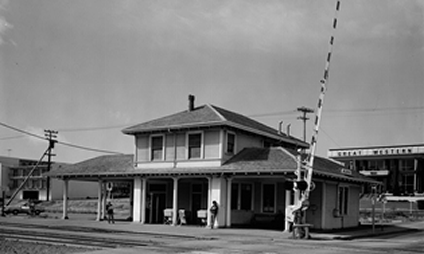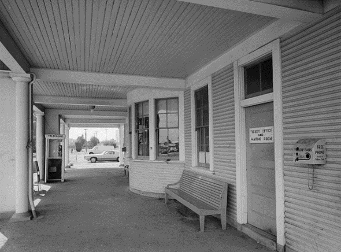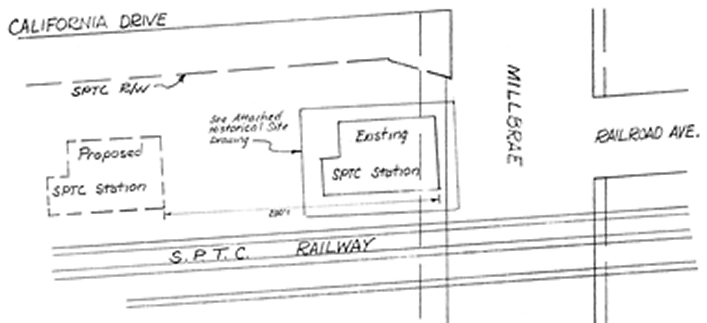The Millbrae Train Museum is housed in the 1907 Southern Pacific depot, which was designed in the Colonial Revival style featuring a colonnade, and was completed in July of 1907. It replaced the previous depot built in 1890 by Southern Pacific, on land deeded to the SF&SJ RR by D.O. Mills in 1865, which burned down in 1906 when a keg of powder inside a boxcar on the siding next to the depot exploded. The original paint colors were most likely those specified in Southern Pacific’s “COMMON STANDARD COLORS for Maintenance of Way Department”, adopted August 1907.


Colonnade Cutoff
Sometime between 1950 and the 1970, Millbrae Avenue was widened enough that the road would now run underneath the northern extension of the colonnade. This would have been rather difficult with the columns still in place—so the city and Southern Pacific apparently agreed to simply remove the colonnade extension. Two of the cast-iron columns were completely removed, and a third was repositioned immediately adjacent to the north-east most column.
1965 Deed Restriction Discovery
Joseph N. Mangin Jr. (long-time local real estate broker) and Dr. Frank Stanger (director of the San Mateo County Historical Museum) alerted the Millbrae Sun newspaper to the reverter clause that D.O. Mills included in the October 16, 1899 transfer of the depot land to Southern Pacific, which would transfer ownership of the land back to the Mills estate should it ever cease to be used for a railroad depot.
1970 Exterior Repainting
The Millbrae Beautification Commission brought pressure to bear on Southern Pacific to re-paint the 1907 structure. With their refusal, the Commission approached the San Mateo County Local Painters Union and attained their promise to donate their services. Southern Pacific refused to allow it but with repeated pressures from the Commission SP finally agreed to and did paint the building yellow with white trim. Related trivia: The Millbrae Historical Society was chartered on March 13 of this year.
1976 Historical Marker Dedication
Southern Pacific proposes that the Millbrae depot be demolished to increase the number of parking spaces, though removing the building would also have reduced their property taxes, and was surely the main reason. On September 5th, 1976, Millbrae Historical Society Marker No. 3 was dedicated in a civic ceremony with SP officials present.
1978 Addition to the National Register of Historic Places
This building was added to the National Register of Historic Places on September 1st, 1978, as National Register No. 78000770.
This depot is one of seven on the Caltrain line that have been listed on the National Register of Historic Places. The others are Burlingame, San Carlos, Menlo Park, Palo Alto, Santa Clara, and San Jose Diridon. The San Francisco & San Jose Railroad’s Colma depot also remains standing, but hasn’t been on the mainline since 1907, and has not even been nominated for listing. Of all of these, only the Colma, Millbrae, and Santa Clara depots have become railroad museums. This was the penultimate conclusion of the Society’s efforts to save the depot from the wrecking ball (we view the opening of the Millbrae Train Museum in the depot as the ultimate conclusion to those efforts).
1979 Historic American Building Survey
On April 28th, 1979, Fred English took 11 interior and exterior photographs of this depot (HABS Survey No. CA-2059), on behalf of the Historic American Building Survey, which was initially run by the U.S. Department of Interior’s Heritage Conservation and Recreation Service—which also launched the nationwide "rails to trails" program—but its duties are now handled by the National Park Service.


1980 Building Move
Years after the northern part of the colonnade was chopped off, Millbrae Avenue was widened yet again, and this time the sidewalk would have run right through the waiting room! So in 1980, Southern Pacific and the city of Millbrae decided to move the depot 200 feet south, to the location where it now stands. The move took place on August 25th. The Millbrae Avenue overpass was built much later, in 1996.

March 14th 1981 Move Celebration
Once the building was settled in at its new location, Southern Pacific, Caltrans, Millbrae city officials, and the Millbrae Historical Society held a celebration of the depot’s reopening at the new location that included train No. 116 with a custom nose sign saluting Millbrae train service from 1864–1981. (The nose sign is on display inside the museum.)
Before the move the depot’s address was 21 East Millbrae Avenue, and the baggage room was 23 East Millbrae Avenue. Neither of these has never been officially changed, and this causes Google Maps to have you walk to the middle of the Millbrae Avenue overpass, leap off the side and walk the rest of the way here. Or you can to use 108 California Drive, which we’ve tested in all major web and smartphone mapping applications. At least one postal carrier has reported their bemusement over the address disparity to museum staff.
1980s Paint Color Research Project
Sometime in the early 1980s, Caltrans District 4 contracted with the California Office of State Architect to conduct paint color research into a number of historic Southern Pacific depots, including Millbrae. For the Millbrae depot, this project was led by John Snyder (now retired). We are still looking for the state’s records of this research, but sometime after this research, the 1970 all-yellow with white trim was painted over with modern paint that approximated the original 1907 colors, albeit without the lead and sanded paint on the lower half of the building.
1990s Exterior Repainting
Sometime in the 1990s, the depot was painted in the current color scheme. We know this because when Caltrain went looking for records of paint colors, they discovered that the Burlingame Sherwin-Williams store had records of the previous paint order, and was able to mix up new batches of exactly the same colors. We’re currently attempting to locate those records in order to nail down the exact date. We’re not sure if this was the first repainting using the 1980s paint color research project, or the second. There was also a period when the building was painted a shade of green that most residents remember despising.
1994 Java Junction Café Opens
In 1994, Paul Stefani and George Stein leased the baggage room, turning it into a coffee shop. The shop operated until 2004, when Caltrain moved the stop to the new Millbrae multi-modal station several hundred feet to the north.
2003 Closure as a Passenger Station
The last day of passenger service at this depot was probably June 21st, 2003—the new Caltrain/BART/SamTrans station opened on June 22nd.
2004 Reopening as the Millbrae Train Museum
On May 15, 2004, the Millbrae Historical Society opened the Millbrae Train Museum inside the waiting room and ticket office of the depot, then on October 23, 2004, the museum held its Grand Opening.
Over the years several significant artifacts have joined the outdoor collection, including the Civic Center (August 12th, 2006), a half-dozen pieces of Southern Pacific baggage handling equipment (2006–2008), a 1931 Ford Model AA restored as a Railroad Express Agency delivery truck (November 5th, 2011), an 1931 Ford model AA fire truck restored and painted to represent the Southern Pacific fire department (March 2013).
2019–2021 Repainting & Renovations
Since April of 2019, the museum and Caltrain have been revamping the building and surrounding areas. Caltrain alone spent about a half-million dollars installing a new roof, new gutters, a nearly complete repainting inside and out, rehabilitating the parking lot, and numerous other upgrades. The museum staff conducted paint color research to arrive at an interim set of interior colors, and has taken advantage of two extended closures (the first for the building rehabilitation and the second for COVID-19) to overhaul the interior layout and reorganize our collections into over 60 discrete exhibits that describe railroad history, technology, and operations—focused on Southern Pacific’s operations on the San Francisco Peninsula. Interesting note: When Caltrain designed the electrification infrastructure, the agency specified a yellow from Federal Standard 595 that they found to be the closest match to the Millbrae depot’s Colonial Yellow—for a full dozen pairs of catenary poles installed from the Millbrae BART/Caltrain station to halfway between Murchison and Trousdale.

